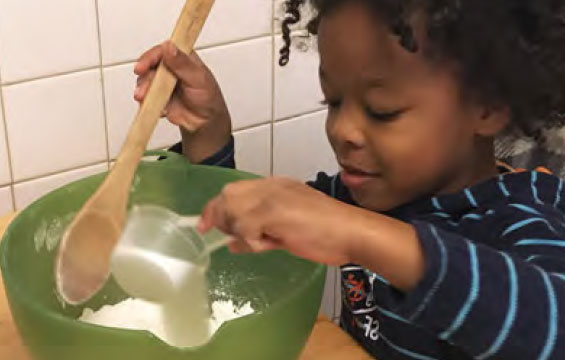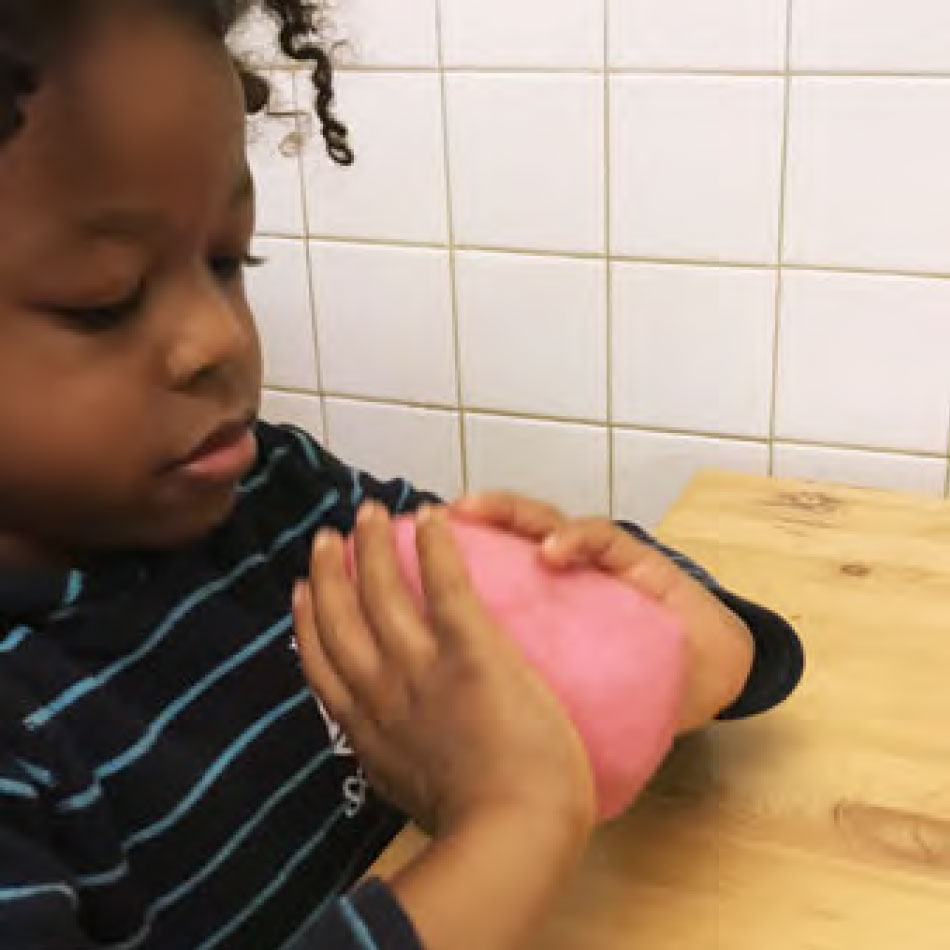Homemade Play Dough
Play with chemistry as you create a classic, kid-friendly compound
- All
- Things to Make

What you’ll need:
Equipment
- A large bowl
- Measuring cups and spoons
- A small saucepan
- A large spoon
- An airtight container for storage (optional)
Ingredients
- 1 cup flour
- 1/2 cup salt
- 2 tsp cream of tartar (optional; it will make your play dough last longer)
- 1 cup water
- 1 tbsp oil
- A couple drops of food colouring (optional)
- Essential oils, food extracts or dried spices of your choice (optional)

Activity setup:
- In a large bowl, mix together the flour, salt and cream of tartar (optional). If you’re using a dry material to add colour or scent to your dough, add it now.
- Combine the water, oil and food colouring (optional) in a small saucepan. If you’re using a wet material to add colour or scent to your dough, add it now.
- Place the saucepan on the stove at a low-to-medium temperature and heat it until it’s warm, about 2–5 minutes. Be sure to ask a grownup for help with this step.
- Add the dry ingredients to the saucepan. Keep the mixture over the heat and stir continuously until the dough starts to form a ball.
- Remove the pan from the heat and set it aside to cool for about 5–10 minutes. Don’t forget to turn the stove off! Once your dough is cool enough to handle, remove it from the saucepan and place it on a flat, clean surface.
- Use your hands to knead the play dough until it’s smooth.
Squish, squeeze and sculpt
Once your dough is smooth, it’s time to play! Have fun squishing, squeezing and sculpting your dough. When you’re done, store your dough in an airtight container in the fridge to keep it fresh for next time you’d like to play. The dough should stay fresh for about 2–3 months in the fridge. If you notice any strange smell or spots on your dough, it’s time to toss it and make a new batch!

How does it work?
Get creative
Experiment with your play dough! Here are a few ideas to try out:
- Make dough with different types of cooking oil, like olive or coconut oil. Does one work better than the others?
- Add dry or wet materials to give your dough a unique scent and/or colour. For example, you could add one of these ingredients:
- A few drops of aromatherapy oil, like lavender
- A few drops of vanilla, peppermint or other food extract
- 1/2 tsp of unsweetened cocoa powder, matcha green tea or ground cinnamon
- 1/2 tsp of pumpkin pie spice for a seasonal scent A package of powdered, unsweetened drink mix (such as Kool-Aid) to provide colour and a fruity scent at the same time
How does it work?
Making play dough is an example of chemistry in everyday life. While making your dough, you created a mixture, solution and chemical reaction.
A mixture is a combination of ingredients that can’t be easily separated from each other. When you combined your dry ingredients of salt, flour and cream of tartar, you formed a mixture. No chemical reaction occurred, meaning none of the ingredients changed. However, it would have been almost impossible to separate them.
In a solution, the molecules of the different ingredients combine completely. By combining water and food colouring, you formed a solution. When you added oil during this step, did you notice that it made little puddles on the surface of the water? Oil and water are immiscible, which means they don’t mix easily. Because oil is less dense than water, it floats on top.
A chemical reaction occurs when a new substance forms. You created a chemical reaction when you combined all of your ingredients together. Many chemical changes happened before your eyes, though you couldn’t see any of them:
- The warm water dissolved the starch in your flour, causing the flour’s protein chains to link together.
- The salt helped these proteins stick together more strongly.
- Cream of tartar is acidic. If you used this ingredient, it prevented the oil from separating out of the mixture.
- The oil caused the molecules in your recipe to slide past each other easily, keeping the play dough soft and moist.
- The ingredients didn’t do all the work, though! By kneading the dough, you helped the proteins from the flour line up in long chains, making your play dough stronger and more elastic.